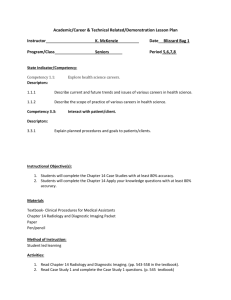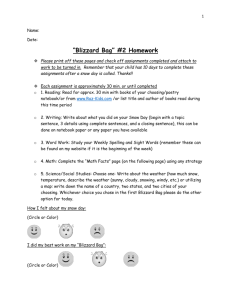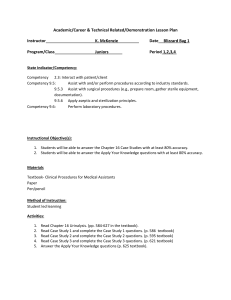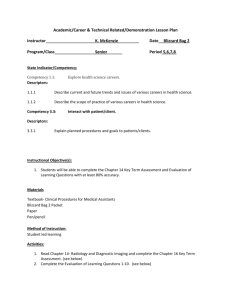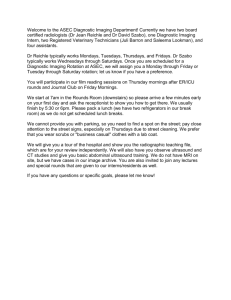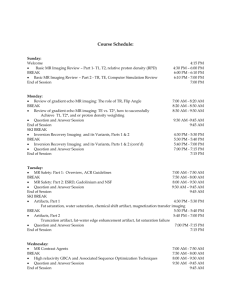Senior Blizzard Bag 3
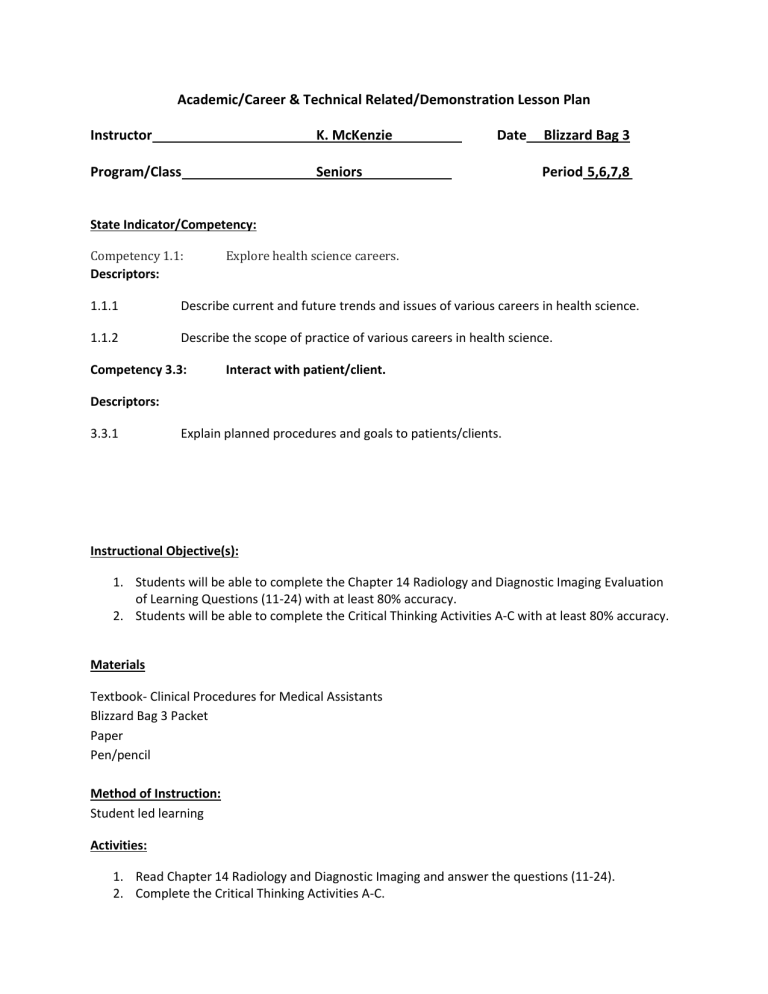
Academic/Career & Technical Related/Demonstration Lesson Plan
Instructor K. McKenzie Date Blizzard Bag 3
Seniors Period 5,6,7,8 Program/Class
State Indicator/Competency:
Competency 1.1:
Descriptors:
Explore health science careers.
1.1.1
1.1.2
Competency 3.3:
Descriptors:
Describe current and future trends and issues of various careers in health science.
Describe the scope of practice of various careers in health science.
Interact with patient/client.
3.3.1 Explain planned procedures and goals to patients/clients.
Instructional Objective(s):
1.
Students will be able to complete the Chapter 14 Radiology and Diagnostic Imaging Evaluation of Learning Questions (11-24) with at least 80% accuracy.
2.
Students will be able to complete the Critical Thinking Activities A-C with at least 80% accuracy.
Materials
Textbook- Clinical Procedures for Medical Assistants
Blizzard Bag 3 Packet
Paper
Pen/pencil
Method of Instruction:
Student led learning
Activities:
1.
Read Chapter 14 Radiology and Diagnostic Imaging and answer the questions (11-24).
2.
Complete the Critical Thinking Activities A-C.
Closure:
Turn in Blizzard Bag 3 on the due date.
Assessment:
Blizzard Bag 3
BLIZZARD BAG 3
ASSIGNMENT 1
11. Why is it important to remove gas and fecal material from the colon before a lower GI radiographic examination is performed?
12. What is an intravenous pyelogram IVP?
13. What type of patient preparation is required for an IVP?
14. Define the following: a. Angiocardiogram b. Bronchogram c. Coronary angiogram d. Cerebral angiogram e. cystogram
15. What are the primary uses of ultrasonography?
16. What are the advantages of ultrasonography?
17. What is the purpose of performing an obstetric ultrasound?
18. What are the primary uses of computed tomography?
19. What type of image is produced by computed tomography?
20. What type of patient preparation is required for computed tomography?
21. What are the primary uses of magnetic resonance imaging?
22. What material is used with a nuclear medicine diagnostic imaging procedure?
23. What are the most common nuclear medicine diagnostic imaging procedures?
24. What are the advantages of digital imaging technology?
BLIZZARD BAG 3
ASSIGNMENT 2
CRITICAL THINKING ACTIVIITES
A.
LOWER GI
Trent Douglas has been having pain in his lower abdomen and occult blood in his stool. Dr.
Hartman tells you to schedule him for a lower GI radiographic examination at Grant Hospital.
Explain how you would instruct Mr. Douglas to prepare for this examination. Include both the patient preparation and the reason for each of the measures.
B.
INTRAVENOUS PYELOGRAM (IVP) at Grant Hospital. After you have explained to Ms. Ray the instructions for preparing for the examination, she asks you the following questions. Respond to them in the space provided.
1.
What body structures will be x-rayed during the exam?
2.
Why must gas and fecal material be removed from the intestines?
3.
Why will iodine be injected into my veins?
4.
Will I feel anything when the iodine is injected?
5.
What is done if an individual is allergic iodine?
C.
MAGNETIC RESONANCE IMAGING
Jason Zindra, a college baseball player, has been experiencing pain in his left shoulder joint. Dr.
Baker schedules him for magnetic resonance imaging on the left shoulder. Jason asks you the following questions regarding this procedure. Respond to them in the space provided.
1.
Is this a safe procedure?
2.
Will there be any pain involved with this procedure?
3.
Will I be exposed to x-rays?
4.
What should I wear to the test?
5.
May I wear my watch during the procedure to keep track of time?
6.
Does the MRI machine make any noise?
7.
Will the technician be in the room with me?
